GERMAN PINSCHER
(Deutscher Pinscher) - MINIATURE PINSCHER
(Zwergpinscher)
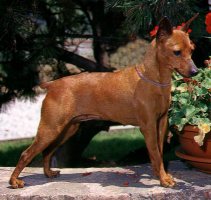
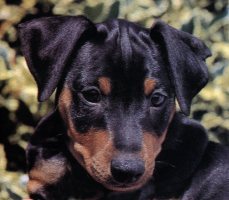
GERMAN PINSCHER
(Deutscher Pinscher)
FCI Standard N° 184 / 18.04.2007/ GB
TRANSLATION : Mrs C. Seidler.
COUNTRY OF ORIGIN: Germany.
DATE OF PUBLICATION OF THE ORIGINAL VALID STANDARD: 06.03.07
SUGGESTED BREEDINGS by MENANDPETS.COM:
No breeding to signal
if you want to know like signaling yours, contacts: marketing@inseparabile.it
.
UTILISATION: Watch and Companion Dog.
CLASSIFICATION FCI: Group 2 Pinscher and Schnauzer-
Molossian breeds - Swiss Mountain and Cattle Dogs and other breeds.
Section 1 Pinscher and Schnauzer type.
Without working trial.
BRIEF HISTORICAL SUMMARY: The smooth haired Pinscher represents a very old breed which was mentioned in the German Stud Book for dogs in 1880 already. He has the same ancestors as the Schnauzer which was also called the rough coated Pinscher. From the beginning the smooth haired Pinschers differed from the rough haired specimen in their colour and their short coat. They were mostly black with light brown markings, self coloured in various shades of brown to red, pepper and salt or simply blue-grey to black.
GENERAL APPEARANCE :The German Pinscher is smooth-haired, medium in size with proud carriage, flowing outlines, elegant and square build. He is strong like the Schnauzer. Due to his short smooth coat, his well developed muscles are clearly visible especially when he moves.
IMPORTANT PROPORTIONS
- In relation of length to height, his build should be as square as possible.
- The length of the head (measured from the tip of the nose to the occiput) corresponds to half the length of the topline (measured from the withers to the set on of the tail).
BEHAVIOUR/TEMPERAMENT : His lively, spirited, self assured and evenly tempered nature combined with intelligence and endurance makes him an agreeable family, watch and companion dog.
HEAD
CRANIAL REGION
Skull : Strong, elongated, without markedly protruding occiput. The forehead is flat and runs parallel to the bridge of nose.
Stop : Slight, yet clearly defined.
FACIAL REGION
Nose: Nose leather well developed and always black.
Muzzle: Ending in a blunt wedge. Bridge of nose straight.
Lips: Black, smooth and tight-fitting to the jaws; corners of mouth closed.
Jaws/Teeth: Strong upper and lower jaw. The complete scissor bite (42 pure white teeth according to the dentition formula) is strong and firmly closing. The chewing muscles are strongly developed without pronounced cheeks interfering with the smooth outline
Eyes: Dark, oval, with black pigmented, close fitting eyelids.
Ears: Drop ears, set high, V-shaped,with inner edges lying close to the cheeks, turned forward towards temples. Folds parallel, should not be above the top of the skull.
NECK : Nobly curved, not too short. Blending smoothly into the withers without any marked set on. Dry,without dewlap or throatiness. Throat skin tight-fitting without folds.
BODY
Topline: Slightly sloping from withers towards rear.
Withers: Forming the highest point in topline.
Back: Strong, short and taut.
Loins: Short, strong and deep. The distance from last rib to hip is short to make the dog appear compact.
Croup: Slightly rounded, imperceptibly blending into tail set on.
Chest: Moderately broad, oval in diameter, reaching to the elbows. The forechest is distinctly marked by the point of the sternum.
Underline and belly : Flanks not too tucked up, forming a nicely curved line with the underside of the ribcage.
TAIL : Natural; a sabre or sickle carriage is sought after.
LIMBS
FOREQUARTERS : Seen from the front the front legs are strong, straight and not close together; seen from the side, the forearms are straight.
Shoulders: The shoulder blade lies close against the rib cage and is well muscled on both sides of the shoulder bone, protruding over the points of the thoracic vertebrae. As sloping as possible and well laid back. forming an angle of appr. 50° to the horizontal.
Upper arm : Lying close to the body, strong and well muscled, forming an angle of 95° to 100° to the shoulder blade.
Elbows: Correctly fitting, turning neither in nor out.
Forearm: Strongly developed and well muscled. Completely straight seen from the front and the side.
Carpal joint: Strong and firm.
Pastern: Strong and slightly springy. Seen from the front, vertical, seen from the side, slightly sloping towards the ground.
Forefeet: Short and round, toes well-knit and arched (cat feet), pads resistant, nails short, black and strong.
HINDQUARTERS : Standing obliquely when seen from the side, standing parallel, but not close together,when seen from the rear.
Upper thigh: Moderately long, broad, strongly muscled.
Stifle: Turning neither in nor out.
Lower thigh : Long and strong, sinewy, running into a strong hock.
Hock : Markedly angulated, strong, firm, turning neither in nor out.
Metatarsus : Vertical to the ground.
Hind feet : Somewhat longer than the forefeet. Toes well-knit and arched. Nails short and black.
GAIT/MOVEMENT :The German Pinscher is a trotter. His back remains firm and rather steady in movement. The movement is harmonious, sure, powerful and uninhibited with good length of stride. Typical of the trot is a ground covering, relaxed, fluent movement with strong drive and free front extension.
SKIN : Tight fitting over the whole body.
COAT
HAIR : Short and dense, smooth, close and shiny without bald patches.
COLOUR
- Self coloured : Deer red, reddish-brown to dark red brown.
- Black and Tan : Lacquer black with red or brown markings.
The aim is for markings as dark, as rich and as clearly defined as possible. The markings are distributed as follows: above the eyes, at the underside of the throat, on the pastern, on the feet, at the inside of the hind legs and under the root of the tail. Two even, clearly separated triangles on the chest.
SIZE AND WEIGHT :
Height at withers : Dogs and bitches: 45 to 50 cm .
Weight : Dogs and bitches: 14 to 20 kg.
FAULTS : Any departure from the foregoing points should be considered a fault and the seriousness with which the fault should be regarded should be in exact proportion to its degree.
Particularly:
- Clumsy or light in build. Too low or too high on leg.
- Heavy or round skull.
- Wrinkles on forehead.
- Short, pointed or narrow muzzle.
- Pincer bite.
- Light, too small or too large eyes.
- Ears set low or very long, unevenly carried.
- Strongly protruding cheekbones (cheekiness).
- Throatiness.
- Too long, tucked up or soft back.
- Roach back.
- Croup falling away.
- Long feet.
- Pacing movement.
- Hackney gait.
- Thin coat.
- Black trace on the back, dark saddle and lightened or pale coat.
- Over- or undersize up to 1 cm.
SERIOUS FAULTS
- Lack of sexual type (i.e. doggy bitch).
- Light appearance
- Apple head.
- Lines of head not parallel.
- Elbows turning out.
- Straight or open hocked hindlegs.
- Hocks turning out.
- Over- or undersize by more than 1 cm but less than 3 cm.
DISQUALIFYING FAULTS
- Shy, aggressive, vicious, markedly suspicious, or nervous behaviour.
- Malformation of any kind.
- Definitely inverse sexual type.
- Faults in mouth, such as over- or undershot or wry mouth.
- Severe faults in individual parts, such as faults in structure, coat or colour.
- Over- or undersize by more than 3 cm.
Any dog clearly showing physical or behavioural abnormalities shall be disqualified.
NB: Male animals should have two apparently normal testicles fully descended into the scrotum.
MINIATURE PINSCHER
(Zwergpinscher)
FCI Standard N° 185 / 18.04.2007/ GB
TRANSLATION: Mrs C. Seidler.
COUNTRY OF ORIGIN : Germany.
DATE OF PUBLICATION OF THE ORIGINAL VALID STANDARD : 06.03.07.
UTILISATION : House and Companion Dog.
CLASSIFICATION FCI : Group 2 Pinscher and Schnauzer- Molossian breeds - Swiss Mountain and Cattle Dogs and other breeds.
Section 1 Pinscher and Schnauzer type.
Without working trial.
BRIEF HISTORICAL SUMMARY : Miniature Pinschers were kept in large numbers around the turn of the century already and the Stud Book for 1925 records no less than 1300 entries. Like with the German Pinscher, from the numerous colour variations, only the colours black with lighter markings and solid red to red-brown were thorough-bred.
GENERAL APPEARANCE : The Miniature Pinscher is a reduced image of the German Pinscher without the draw-backs of a dwarfed appearance. His elegant square build is clearly visible due to his short smooth coat.
IMPORTANT PROPORTIONS :
- The ratio from length to height shall make his build appear as square as possible.
- The length of the head (measured fom the tip of the nose to the occiput) corresponds to half the length of the topline (measured from the withers to the set on of the tail).
BEHAVIOUR/TEMPERAMENT : Lively, spirited, self assured and evenly tempered. These qualities make him an agreeable family and companion dog.
HEAD
CRANIAL REGION
Skull : Strong, elongated without markedly protruding occiput. The forehead is flat without wrinkles, running parallel to the bridge of nose.
Stop: Slight, yet clearly defined.
FACIAL REGION
Nose: Noseleather well developed and black.
Muzzle: Ending in a blunt wedge. Bridge of nose straight.
Lips: Black, smooth and tight-fitting to the jaw. Corners of lips closed.
Jaws/Teeth : Strong upper and lower jaw. The complete scissor bite (42 pure white teeth according to the dentition formula), is strong and firmly closing. The chewing muscles are strongly developed without pronounced cheeks interfering with the smooth outline.
Eyes: Dark, oval, with black pigmented close fitting eyelids.
Ears : Prick ears ; drop ears, set high, V-shaped with the inner edges lying close to the cheeks, turned forward towards temples. Folds parallel, should not be above the top of the skull.
NECK : Nobly curved, not too short. Blending smoothly into the withers without any marked set on. Dry without dewlap or throatiness. Throat skin tight-fitting without folds.
BODY
Topline: Slightly sloping from withers towards rear.
Withers: Forming the highest point in topline.
Back: Strong, short and taut.
Loins: Strong. The distance from last rib to hip is short to make the dog appear compact.
Croup: Slightly rounded, imperceptibly blending into tail set on.
Chest: Moderately broad, oval in diameter, reaching to elbows. The forechest is distinctly marked by the point of the sternum.
Underline and belly : Flanks not too tucked up, forming a nicely curved line with the underside of the brisket.
TAIL: Natural; a sabre or sickle carriage is sought after.
LIMBS
FOREQUARTERS : Seen from the front, the front legs are strong, straight and not close together. Seen from the side, the forearms are straight.
Shoulders: The shoulder blade lies close against the ribcage and is well muscled on both sides of the shoulder bone, protruding over the points of the thoracic vertebrae. As sloping as possible and well laid back, forming an angle of appr. 50° to the horizontal.
Upper arm: Lying close to the body, strong and well muscled, forming an angle of 95° to 100° to the shoulder blade.
Elbows: Correctly fitting, turning neither in nor out.
Forearm: Strongly developed and well muscled. Completely straight seen from the front and the side.
Carpal joint: Strong and firm.
Pastern: Strong and springy. Seen from the front,vertical, seen from the side, slightly sloping towards the ground.
Forefeet: Short and round, toes well-knit and arched (cat feet), pads resistant, nails short, black and strong.
HINDQUARTERS : Standing obliquely, when seen from the side, standing parallel but not close together seen from the rear.
Upper thigh: Moderately long, broad, strongly muscled.
Stifle: Turning neither in nor out.
Lower thigh: Long and strong, sinewy, running into a strong hock.
Hock: Markedly angulated, strong, firm, turning neither in nor out.
Metatarsus : Vertical to the ground.
Hind feet: Somewhat longer than forefeet. Toes well-knit and arched. Nails short and black.
GAIT/MOVEMENT : The Miniature Pinscher is a trotter. His back remains firm and rather steady in movement. The movement is harmonious, sure, powerful and uninhibited with good length of stride. Typical of the trot is a ground covering, relaxed, fluent movement with strong drive and free front extension.
SKIN : Tight fitting over the whole body.
COAT
HAIR : Short and dense, smooth, close and shiny without bald patches.
COLOUR
- Self coloured : Deer red, reddish-brown to dark red brown.
- Black and Tan : Lacquer black with red or brown markings.
The aim is for markings as dark, as rich and as clearly defined as possible. The markings are distributed as follows: Above the eyes, at the underside of the throat, on the pasterns, on the feet, at the inside of the hind legs and under the root of the tail. Two even, clearly separated triangles on the chest.
SIZE AND WEIGHT
Height at withers : Dogs and bitches: 25 to 30 cm.
Weight : Dogs and bitches: 4 to 6 kg.
FAULTS : Any departure from the foregoing points should be considered a fault and the seriousness with which the fault should be regarded should be in exact proportion to its degree.
Particularly:
- Clumsy or light in build. Too low or too high on leg.
- Heavy or round skull.
- Wrinkles on forehead.
- Short, pointed or narrow muzzle.
- Pincer bite.
- Light, too small or too large eyes.
- Ears set low or very long, unevenly carried.
- Throatiness.
- Too long, tucked up or soft back.
- Roach back.
- Croup falling away.
- Long feet.
- Pacing movement.
- Hackney gait.
- Thin coat.
- Roans; black trace on the back, dark saddle and lightened or pale coat.
- Over- or undersize up to 1 cm.
SERIOUS FAULTS :
- Lack of sexual type (i.e. doggy bitch).
- Light appearance
- Apple head.
- Lines of head not parallel.
- Elbows turning out.
- Hindlegs standing under the body.
- Straight or open hocked hindlegs.
- Hocks turning out.
- Over- or undersize by more than 1 cm but less than 2 cm.
DISQUALIFYING FAULTS :
- Shy, aggressive, vicious, markedly suspicious, or nervous
behaviour.
- Malformation of any kind.
- Lack of breed type.
- Faults in mouth, such as over- or undershot or wry mouth.
- Severe faults in individual parts, such as faults in structure, coat or colour.
- Over- or undersize by more than 2 cm.
Any dog clearly showing physical or behavioural abnormalities shall be disqualified.
NB: Male animals should have two apparently normal testicles fully descended into the scrotum.
Automatic TRanslate from inseparabile.com
The Zwergpinscher a small, compact, muscoloso dog, from the smooth and lucente hair, with of the square proportions and one ben-cesellata line. The back to the straight one or tilted leggermente towards the posterior part. The front legs are straight and the spurs have been removed. The legs are small and tiny, from cat. The sturdy snout and very proporzionato to the rest of the body. The teeth would have to be closed in the bitten classic to scissor. The eyes are dark and of shape oval. The cut of the ears optional while the tail always comes cut. The cape of the Zwergpinscher has a hair short and easy to hold and usually of red color but pu to find itself also in the tonalit of black with focature the rossiccie or chocolate. This dog while it walks raises particularly legs from earth.
Origins:
The Zwergpinscher not connected with the Dobermann and in devout effects one ancient race of the Dobermann. Developed in Germany from the breeds of the terrier comprised the German Pinscher, the scope in origin of the Zwergpinscher was that one to hunt the rats in the stables where normally they lived holding cos to uneccessiva brake and fast reproduction. The blood of the Italian levriero small pu to be added in order to give a raised elegant step and with that particular one of leg. The Pinscher word means terrier in German. Today vivacit and the personalit raggiante of the Zwergpinscher, they render it a companion fascinating. Some pregi of the Zwergpinscher are lobbedienza, one detached attitude to the guard and lagilit.
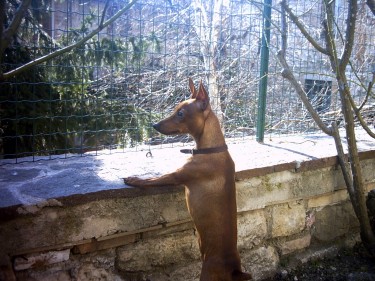
Gera to 8 months of landslides
Temperament:
The Zwergpinscher a small and brave companion, a lot demanding and cocciuto. This fierce, arrogant and excessive brave dog barks with facilit. And loyal towards lively, careful and energetic its landladies. Intelligent, lively and for null frightening, a great dog in the spiritoma small in the body! The moderately protecting Zwergpinscher. Some dogs of this race can be much aggressive in the comparisons of the other dogs but generally they are good is with the domestic animals in kind, is with the children on condition that questultimi they do not annoy them. They are rather suspicious towards the disowned ones but this depends from as they have been accustoms to you since puppys and if they have had one good socialization. It does not have to ruin this race too much or the dog pu to become a tyrant.
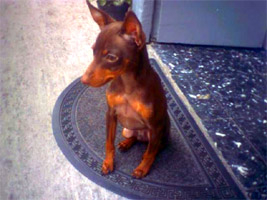
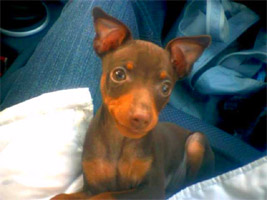
in the Tobia photos of siria76
The Zwergpinscher pu to learn a lot just and what it wishes. For its socialization sure convenient to carry the dog from cucciolo to the course where pu to come to contact with other dogs and persons. You will remain surprises for the velocit with which the your Zwergpinscher to understand to you and to obey. Lend particular attention to when sporcher in house, in as far as times seen the small pool that ago, it does not come sgridato but this mistaken in how much the dog to understand that you will be happy daily for accepting its bisognini in house. The Miniature Pinscher often called the king of the toy. It must be a lot attention to what masticher in how much if giocher with of small pieces potr risking to suffocate. Dargli not to eat too much.
Weight and height:
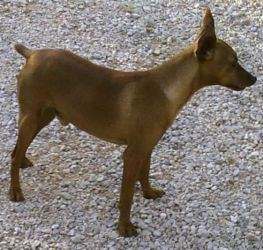
the subject of the photo of angel8181
Height: male 25 - 30 cm female 25 28 cm
Weight: male 4 5 kg female 4 kg approximately
Problems of health:
This one race much healthy one.
Living conditions:
The Zwergpinscher life adapted for one happy dappartamento and sar also without a garden. It would have protect just the Zwergpinscher from the cold.
Exercise:
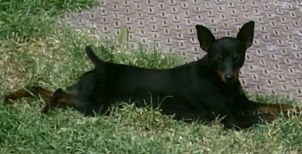
the subject of the photo of angel8181
These dogs do not demand much physical exercise but it would have to be given they in regular way of the occasions in order to run and to play. To make attention that the space where the free Zwergpinscher to run and to jump is protect from one enough high recinzione to prevent every its attempt of escape, in how much a curious dog and yearning to explore the world around to he.
Longevit:
Approximately 15 devout years or.
Cures:
The Zwergpinscher has a smooth cape, with a hard and short hair, for this easy one to hold in order. To brush it constantly baster in order to hold it clean and potr fargli a beautiful one bagnetto with a lot of shampoo if only necessary. In order to remove the dead hair pu to use a cloth of cotton inumidito with dellacqua warm. This race has one dumb average.
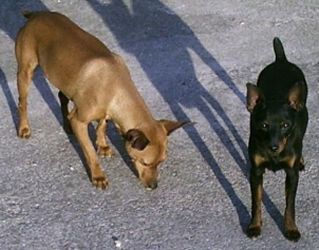
the subjects of the photo are of angel8181